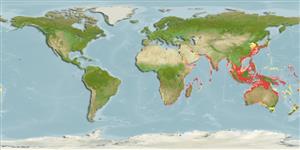Preferred temperature (Ref.
115969): 21.7 - 29.1, mean 28 (based on 2108 cells).
Phylogenetic diversity index (Ref.
82804): PD
50 = 0.6250 [Uniqueness, from 0.5 = low to 2.0 = high].
Bayesian length-weight: a=0.00182 (0.00101 - 0.00327), b=2.91 (2.74 - 3.08), in cm Total Length, based on LWR estimates for this species & (Sub)family-body (Ref.
93245).
Nível Trófico (Ref.
69278): 4.0 ±0.67 se; based on food items.
Resiliência (Ref.
120179): Elevada, tempo mínimo de duplicação da população menor que 15 meses (Fec=17,475).
Prior r = 0.76, 95% CL = 0.50 - 1.14, Based on 1 full stock assessment.
Fishing Vulnerability (Ref.
59153): High vulnerability (62 of 100).
